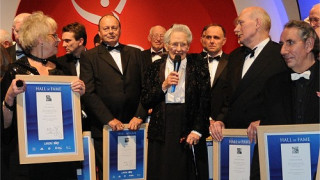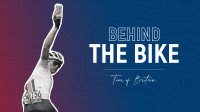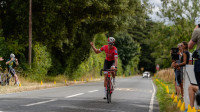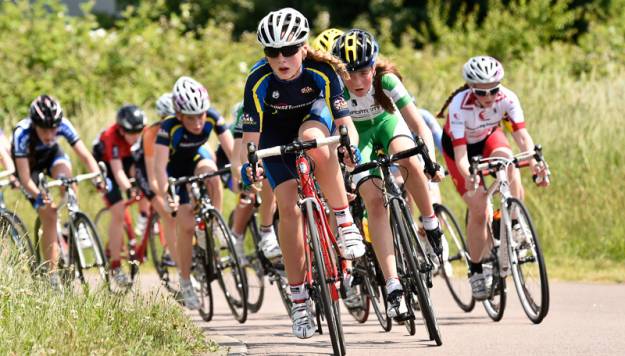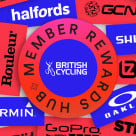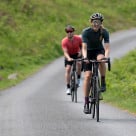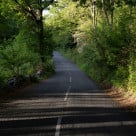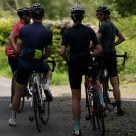Interview: Eileen Gray CBE
Story posted June 02, 2010; by Belinda Sinclair
One of the 50 Cycling heroes named in British Cycling's Hall of Fame was Eileen Gray CBE who attended the Gala Dinner earlier in the year. British Cycling sent correspondent Belinda Sinclair to see her in London and capture a glimpse of her amazing life and struggle for Women's cycling.
Talking to Eileen Gray CBE
It’s very easy when you are used to just doing things, to assume that it has always been that way. Afterall, why wouldn’t you? But reality is that things that we often take for granted were derived – quite recently – from hard fought battles, the details of which quickly slip into oblivion once the outcome takes root. Take for example Women’s racing. Although arguably opportunities are still not as commonplace as men’s, particularly at the lower levels, women cyclists, women’s races, and women champions are now very much established within the sport.
Take for example Women’s racing. Although arguably opportunities are still not as commonplace as men’s, particularly at the lower levels, women cyclists, women’s races, and women champions are now very much established within the sport.
And much of the credit for that must go to the very determined Eileen Gray CBE, a woman recently inducted into the BCF Hall of Fame, and without whom, the likes of Victoria Pendleton, Rebecca Romero, Nicole Cooke or indeed Beryl Burton might never have had the opportunity over the years, to spin their wheels as successfully as they have.
Eileen Gray is the sort of woman who you just know means business. Now ninety, she still has that air of confidence and calm determination that coupled with pragmatism and clear vision, means that she will achieve what she sets out to do. And according to her, that is all that she needed to set up cycle racing for women and set it on course for the world stage that it now occupies. Well, that and a bike of her own.
Finding her love of the bike in the War years
Recalling her early years, Eileen explains “I was really shy as a young girl. Timid and very mousey. And I would probably have stayed that way had it not been for this old bike that I was given during the war. I can’t remember where it came from but I do know that it was the one thing that changed me from that shy young woman into the confident person that I became. It wasn’t planned, it just happened, and I don’t think I really realised quite the impact it made until much later on. It sort of opened that way for me I suppose.”
One of a large family, Eileen was born in Bermondsey, but moved to Dulwich as a youngster. She lived not far from the Herne Hill Velodrome and although she remembers pre war cycle events there, the cycle bug did not bite her until well into the war years. “It started as a bit of a ‘I’ll show you’ sort of thing really. Mum was ill and in the Maudsley Hospital, so I didn’t get called up for the forces but went into a reserved occupation instead so that I could look after her. I had always been good at maths and so I went into engineering."
"I was based over near Harrow Road, which was a bit of a trek but I always got there on time and did my thing checking bits of engine and then stamping 99 on them to show that I’d quality controlled them. But one day, all the buses and trains went on strike and I was late. Not very late, but late enough and although the supervisor knew about the strike and that it really wasn’t my fault, he told me off. I thought ‘right, you’re not getting me again’. So after that, I rode that old bike to work. The way I looked at it, anything that happened then was down to me and me alone. So I rode to Harrow Road and back everyday – round the rubble and the potholes, through all weathers, night and day, but I was never late again, and he never had another opportunity to tell me off.”
But the permanent move to two wheels did something to Eileen, and she was never the same again.
“Well, it was the freedom! I loved it. I could go places and see things that I would never have seen if I’d stayed home and I was my own boss. Nobody had any money then, so if you wanted to do stuff, you had to just get on and do it. So cycling became the thing for me. Years before, a doctor looking after Mum had remarked that I was different from the rest of my family and when he discovered that I cycled, he said ‘that’s it, that’s what’s made you different’. I didn’t really think about it at the time, but getting on my bike after the episode with that supervisor, I knew the doctor had been right. I was very determined, even back then and I knew I wanted to be in control of my own life, not have people – especially men - making up rules for me while they did as they pleased.”
And so, Eileen joined the Apollo Cycling Club.
“They were near to where I lived in Dulwich but I had to join them because none of the other clubs – not even the Addiscombe or the Paragon - allowed women to ride. But the Apollo was great and very welcoming. I made so many friends. Sid Butler and his wife Ann (parents of Keith, later to become a pro and now promoter of the Surrey Road Race League) became particularly good friends and really encouraged me. Mind you, I had to be pushed home from my first club run because I was so tired, but I kept going back for more!“
Eileen continued cycling throughout the remainder of the war, joining the National Cyclists Union (NCU) who ran ‘Holidays at Home’ as part of the war effort. By the time the war ended, she was an accomplished cyclist who rode her bike everywhere.
Eileen (with the microphone) wowed the audience at the 2010 Gala dinner with just one of many stories she has to tell.
A first for Women
Post war Europe was a very broken place but sport began to emerge as a means of rebuilding international contact and generating new ties and relationships. Cycling became central to that, being one of the few methods of transport or leisure relatively unaffected by damaged vehicles or roads, or petrol shortages. In 1946, a track cycle event was held at Ordurp in Copenhagen, Denmark.
Unusually, the organisers decided to stage a curiosity event – a women’s race and invited three British women cyclists to ride the exhibition event. One was Eileen Gray, and it was the first ever British Women’s International team.
“It was a great opportunity for us. I mean, not only were we being invited abroad but we were going to be allowed to ride our bikes against a Danish team; Stella Farrell, Joan Simmons and me. It sounds daft now, but being allowed was a big thing. People today would laugh at even the suggestion that permission had to be given by half of society to the other half to do something that they did as part of everyday life, but that’s the way it was back then."
"Men ruled women and women had to wait to be invited, never mind they’d kept the whole country and the war effort going on their own for six years, as well as looking after their kids and doing women stuff - and all for only two thirds of the pay. But this was our chance – an invitation to show what we could do!”
Not surprisingly, Eileen and her two equally determined compatriots romped home to an impressive victory but unlike the men’s event, there were no medals or titles.
“Oh no, they just wanted us there as a side show but what they didn’t realise was that they’d given us a platform, visibility, and a chance to show what we could do. And other women saw us too and must have thought ‘if they can do it, so can I’ and from that point on, something started that they couldn’t stop. And what’s more, we found out later that the Danish girls we’d been up against were part of a theatrical troupe who rode bikes as part of their act. Well, they made a big mistake there because we were all good cyclists and we knew how to race, so we won very convincingly and really stood out.”
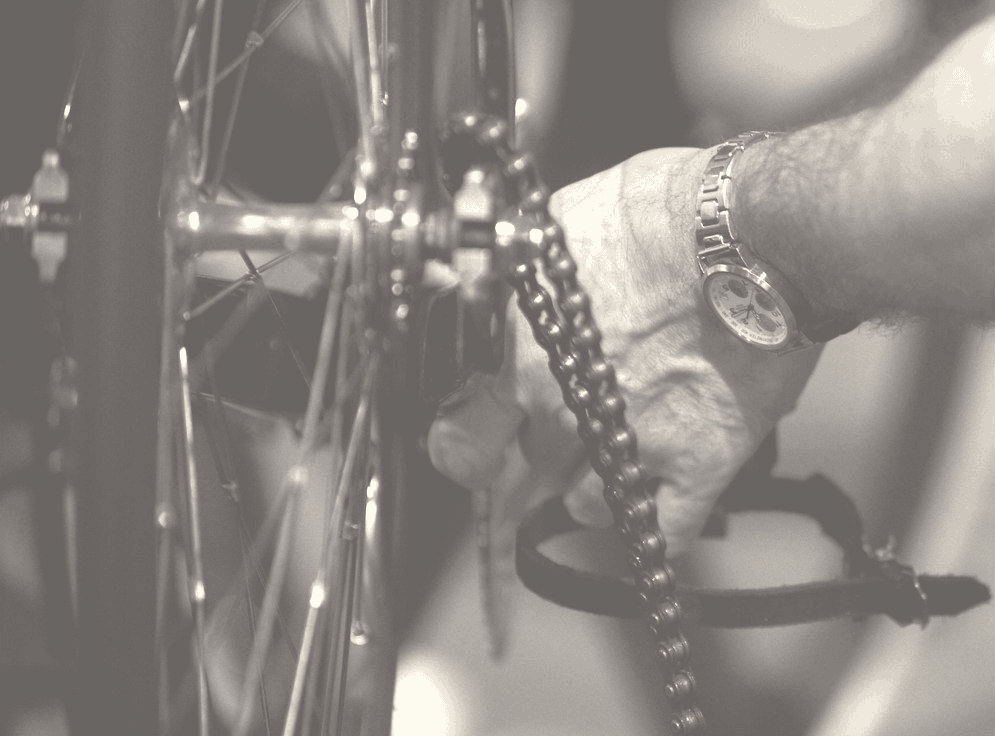
A team of young riders taken to Belgium in 2007 by Bryan Taylor wearing the WCRA jerseys
The beginning of Women's racing
From then on, albeit very slowly, women’s cycling started to emerge, particularly in mainland Europe. “The French were up for it, as were the Belgians, but surprisingly, it was the Dutch who were very much against women racing. We’d try and push for women’s events to be included in event calendars but the Dutch just wouldn’t budge."
"The Swiss and the Italians weren’t very helpful either but the seed was well and truly sown by then. We knew that if we kept pushing, we would get somewhere, but that it would probably take a very long time to get women’s cycling accepted on its own merit.”
It took another eleven years before the first event specifically for women was formally staged – the World Championships in France in 1958, although in the meantime, Eileen had been nibbling away at the British authorities, with some success.
“We kept on pushing but by 1955, we were still not making a great deal of progress in obtaining World Championships for Women, so I got the NCU to push the UCI to recognise Women’s World records. They managed to get that at the annual congress in Paris that year, so that was a big step in the right direction. I think that was in March but it was key because soon after that, the Women’s Track Racing Association (WTRA) organised the first World record attempt at Herne Hill."
"That was the one where Daisy Franks established the 500 metre flying start, but so that we could comply with UCI regulations, we had to sandbag the bends on the track. But of course, we had no sandbags, so the girls got together, made the bags and then filled them with sand out of the middle up there”.
That was the real start of things and women’s racing started to establish itself from that year. As Eileen noted, track racing was booming during this period, although not for the same reasons as it had done in Denmark when she’d raced. “The crowds there used to bet on cyclists and it was a big thing - a bit like the horses or the dogs. I’m not sure what they classed us girls as, but there was certainly a lot of interest in us, although I’m pretty sure that the odds hadn’t been that great. But we’d come along way since that event in Copenhagen, and although it had been a hard slog and there was a long way to go, 1955 was a big year for us.”
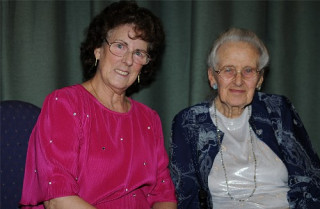
Girl power! Two stalwarts of the sport together at a British Cycling awards dinner in 2009, Dorren Mallinson (left) and Eileen Gray.
Indeed, following the Daisy Franks record and later World records by Joy Bell and Kay Hawkins, the French invited a British team to a three day stage race at Roanne.
“This was another huge landmark for us and getting women’s racing accepted. The team that went was the very first team to race in France and they beat the French easily, which I don’t think had been in the French plan! Millie Robinson won, with June Thackeray second. Kay Hawkins came seventh, Bobby Tingey ninth; Beryl French also rode but I’m afraid I can’t remember where she came. This was also my first event as team manager, so to have started with a win was very special".
"I was really proud of the girls and riding as they had. And do you know what? They all donated all of their prize money so that we could start the Women’s International Racing Fund and that fund supported women’s teams abroad for a long time after that.”
A nice little addition to the team’s success was the additional publicity it caused in France, prompting a promoter to stage a five day event which he called “Le Tour de France Feminine”, which apparently upset a few people in France but created more welcome publicity for the victorious British women. “Millie won that as well and set herself up as the outstanding rider of the year. Tom Crowther was our mechanic and he did a fantastic job. My husband Wally was also very supportive, and promoted women’s races in his events but even though these girls were proving themselves over and over again, there were still men who wouldn’t recognise their achievements.”
In the autumn of 1955, these women were invited to race in the Polytechnic Grand Prix Roller competition, which was televised. They also wore WTRA vests and were recognised as a team in their own right, there on merit. “I remember that clearly too" Eileen says. "Ellen Carrington won, followed by Bobby Tingey and Kay Hawkins. It was a huge achievement for women all round to be accepted like that and also an indication that the old permission hurdle was becoming less and less, although it was still there.”
By this time, Eileen had been married for nearly ten years, had had a son, and stopped competing. Had the success of other women been hard for her? Had she wished she had been able to race as they had? “No, not really" she replied. "I had my son in 1947 and that was at a time when there was still nothing much about for women cyclists, so ‘giving up’ didn’t really apply to me as it would do nowadays. I didn’t have a sense of missing out to have a family."
"But because I had been so involved for so long and my husband (Wally Gray, time trialist with the Archer Club and promoter) was still racing, I knew a lot of people and remained around cycling. So I suppose I had naturally turned my attentions to organising and pushing to establish events for the girls. Again, it just sort of happened and I don’t think I really realised what I’d done until things started happening a few years later. I just did it and used my contacts to make things happen where I could.”

Eileen was a popular person to catch up with at the Gala dinner in 2010.
In Britain in those days, domestic road events were big, particularly where long distances were involved. “Well, there was all that debacle where cyclists weren’t allowed to race on the roads and events had to be kept secret in case the police found out and continental style road races were discouraged. But people still rode and things like Lands End to John O’Groats and 100 mile time trials, 24 hour endurance events and the like, became popular."
"We pushed for women’s records on those too and the Women’s Road Race Association came out of that. Another important one was the London to Brighton record. Beryl Burton was an important rider in those types of events – a very determined woman. Another one was Jean Dunne, also a very good rider who gave her all.”
A little before that however, women had finally been allowed to compete on the road and this had prompted the WTRA to change its name to the Women’s Cycle Racing Association (WCRA) and the riders wore green and white jerseys. The Association had to buy these themselves however, as the NCU (later the BCF) did not supply women with team kit. By 1956,their combined determination and hard work was starting to get noticed. A national Road Race Championship to complement the WCRA event was eventually approved and went ahead in May.
“Millie Robinson won that and became the first ever national road race champion with Joan Poole in second and Joy Bell third. Bobby and Norman Tingey promoted that and did a wonderful job.”
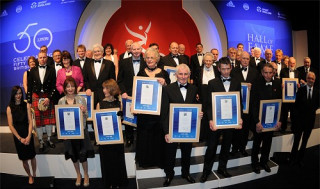
Eileen, 90, lines up for the Hall of Fame picture at this year's Gala Dinner.
Getting Noticed
The power of press coverage was beginning to take hold too. “Well you see, there had been so much reporting after the two stage races in France the previous year, and cycling in general was so popular, that things started to happen. The Harrogate Festival decided to include a women’s race in their programme; it was the first ever international road race for women to be held in Britain and Millie won that in a break away.”
The Roanne event in France that year was also extended to eight days, enabling women’s racing to be included. “Looking back, it seems quite odd now, but the NCU chose the team which included Millie, June Thackeray, Joan Poole, Bobby Tingey and two others, but when two American girls crashed, we lent them two of our riders – Beryl French and Joy Bell. Beryl won and beat Millie who had lost her gearing on the last stage. So it was a British girl who secured victory for the Americans.“
However, as Eileen remembers only too well, there was still much opposition to women racing, often from surprising quarters. “Reg Harris was a bit of a nuisance and banned women from racing at one track. I don’t really know why because the girls had proved themselves time and time again but for some reason, he didn’t like it. But that only made us more determined to succeed although it would have been nice to have had even a little of the amount of help that he’s had. But we were never going to get it. Then later on, we had instances of actual sabotage to stop us riding. And do you know what, the saboteurs were British men out to stop British women racing. Isn’t that shocking – but it’s absolutely true.”
She recalled one incident in particular when she had taken a team of girls to Leipzig to race. Having been given one hundred pounds by the BCF to enter, support, feed the riders, buy spares, and cover travel costs, the women set about raising the rest of the money that they needed themselves. “We did all sorts of things to raise the cash and someone had a big old bus and he drove us down there."
"Towards the end of the event, this person who is very well known in the world of cycling, got all funny with us and went home. I think he and his riders had finished but he deliberately took all of our spare tubes and tyres with him leaving us with nothing. And they were spares which we’d bought with the money that we had raised. They didn’t belong to the BCF and they certainly weren’t his, but he took them all the same, leaving us with nothing."
"He just did it to harm our chances. And it makes my blood boil to this day to hear him lauded for his contribution to UK cycling when he did that to us.”
However, despite the underhand dealings on that occasion, the women left Leipzig with two gold medals, a silver and a bronze. “There was still nothing for the girls financially though. No help, no support. Just that £100 and a man who’d nicked our stuff!"
Having helped women’s cycling onto the national and international stage and kept it there, Eileen began to develop further opportunities as other women started to get involved. "Well, I was on the finance committee for a long time – the only woman of course – but it meant that at last I was in a position where I could get things going and say my bit for women."
"I’d been around for a long time then and I knew a lot of people. I remember we used to meet in Blackfriars Road in those days because there was a great egg and chip shop there where we could sit down and sort stuff out. We didn’t have offices or anything but I think that was actually part of our success; we had nothing so they only way was forward!”
A royal chain for Eileen
A measure of progress came in the 1970s at the World Championships held that year in Leicester. Bike manufacturers Raleigh decided that the president of the BCF should have a badge of office, something to distinguish who they were. By that time, Eileen was president and became the first incumbent of the specially designed insignia.
“Well Raleigh decided to go the whole hog and do something which turned out to be quite impressive. They had this chain designed which was very grand and mayoral but when they took it to the jeweller, he refused to make it because it contained the Royal Standard. But it turned out that in the 1860s or 70s, the Bicycle Union as it was known then, had actually been given permission to incorporate the Standard in their insignia and so it was duly made and presented to me as president as a chain of office. I did wear it when I was supposed to because to me it signified the struggle that we women had had to get there. And anyway, it was quite nice!”
In 1976, the London Youth Games began and Eileen was the prime over in that too. “We wanted to mark the Queen’s Silver Jubilee and a sporting event for kids from all over London seemed an appropriate way to mark that milestone and give youth sporting achievement gravitas. It took off really well and hag grown every year since. So on her Golden Jubilee, it was our Silver, and the Queen came along to the Games. She was wonderful with the kids and spent about 45 minutes in the hall surrounded by them while they asked her questions and she asked them about their sports. None of that was planned, it just sort of happened which I think alarmed her people at first but it really made the event and was really special for a lot of the young athletes there. She really made the event.”
In later years, Eileen was awarded the MBE and then the CBE. “I had to give the MBE back when they gave me the CBE. I don’t know what happened to it – maybe it got recycled!” She has also held several other public offices. “I was Deputy Commandant of the Olympic Team. In those days, the Winter and Summer Olympics were held in the same year, so I was DC for Albertville and Barcelona. Then between 1990 and 1999, I was mayor of the Royal Borough of Kingston Upon Thames. I think I was quite a good mayor; I hope I was. I made it my business to get out and about and talk to people, help them get their ideas heard and I tried to encourage them to do things that they wanted to do.”
Having sat and talked to Eileen Gray for an afternoon, I have absolutely no doubt that she was more than quite good. For one woman, she has opened the doors of opportunity for so many other people for generations, a sort of early day Mrs Fixit. Yet, while she had never been a supported athlete herself, she had derived very little personal benefit for her efforts other than having the satisfaction of having taken on the kingmakers and seen many of them portray her success as their own.
If anybody deserved a place in the Hall of Fame, it most definitely is Eileen Gray.
Related Stories
50 Cycling Heroes Named in British Cycling's Hall of Fame
Feature on the 2010 Gala Dinner

